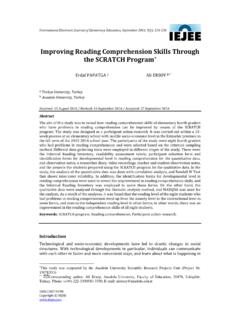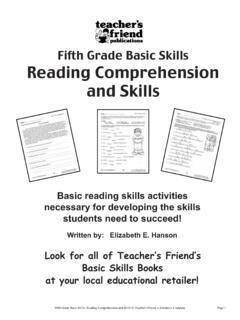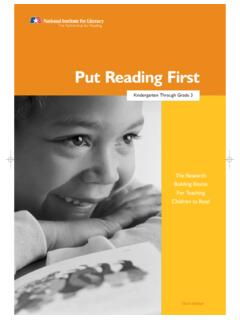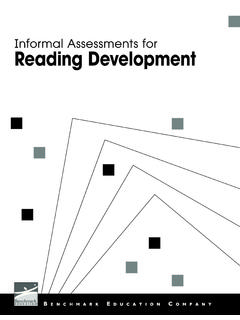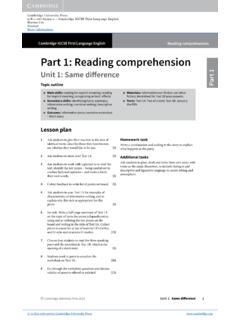Transcription of The Effect of Three Reading Comprehension Strategies on ...
1 The Effect of Three Reading Comprehension Strategies on Reading Comprehension when Reading digital informational Texts by Michael D. Plocher Thesis Submitted in partial fulfillment of the requirements for the Master of Science Degree in Education Graduate Studies Martin Luther College New Ulm, MN July 2016 Reading Comprehension Strategies 2 Signature Page Date: This thesis paper has been examined and approved. Review Committee: _____ James Grunwald, Chair _____ Carrie Pfeifer _____ Paul Tess Approved: _____ John Meyer Director of Graduate Studies Reading Comprehension Strategies 3 Abstract This study explored the effects of Three Reading Comprehension Strategies : Cloze Reading Comprehension Activity, Reading Road Map (RRM), and Survey-Question-Read-Recite-Review (SQRRR) on Reading Comprehension when Reading digital informational texts. The participants were 48 students in either 7th or 8th grade with 36 or 75% of those students having a Reading Comprehension ability at or above their grade level as measured by Scholastic Reading Inventory software.
2 A one-way analysis of variance (ANOVA) of the Reading Comprehension ability of the Three groups of participants as measured by Scholastic Reading Inventory software suggested there were no statistically significant differences in the means of the Reading Comprehension ability of the Three groups. A non-equivalent groups pretest/post-test comparison group design was employed that examined the Three treatments. The primary analysis evaluated treatment effects by conducting a one-way analysis of covariance (ANCOVA). Results suggested that the 3 Reading Comprehension Strategies in this study have the same Effect on Reading Comprehension when digital informational texts are read. Reading Comprehension Strategies 4 Acknowledgments All thanks and honor belong to my God and Savior, Jesus Christ. He has redeemed me a lost and condemned creature and preserves me richly and daily by providing me with many blessings, first and foremost is eternal life in heaven with him. For this I strive to live a life worthy of the calling he has given to me.
3 I would like to thank Drs. Jim Grunwald, Carrie Pfeifer, John Meyer, and Professor Paul Tess, for their useful comments and encouragement through the learning process of this master thesis. I would like to thank my step-father, Dr. Roger Klockziem who helped me crystalize the topic I wanted to explore and continued to be a sounding board when I had questions along the way. I also want to thank St. Paul s principal, Greg Thiesfeldt, and fellow teacher Steve Biedenbender. Greg, for encouraging me to pursue my master degree knowing it was something that I had planned to do but struggled to find the time to start, and both Greg and Steve for quietly listening to me talk to them and smiling as I disappeared out of their classrooms to continue my work. Also, I would like to thank St. Paul s Lutheran Church for providing financial support towards my master thesis. Finally, I would like to thank my family who have supported me through the entire process, and especially my wife, Susan.
4 She was my proofreader, encourager, and friend and would nudge me when needed, always showing love as I worked to put the pieces of this thesis together. I will be forever grateful for her love and support. Reading Comprehension Strategies 5 Table of Contents Abstract .. 3 Table of Contents .. 5 List of Tables .. 7 Chapter I: Introduction .. 8 Introduction .. 8 Problem Statement .. 8 Purpose of the Study .. 9 Research Questions .. 10 Definition of 10 Assumptions and Limitations of the Study .. 11 Overview .. 12 Chapter II: Literature Review .. 13 Introduction .. 13 Reading digital Texts .. 13 Student Interaction with digital Text .. 14 Expanded Definition of Literacy .. 15 Bridging Print and digital Literacies .. 17 Summary .. 17 Chapter III: Methodology .. 18 Introduction .. 18 Research Questions .. 18 Research Design and Procedures .. 18 Population and Sample .. 20 Instrumentation .. 22 Data Analysis Procedures .. 23 Limitations .. 23 Summary .. 24 Chapter IV: Results .. 25 Introduction.
5 25 Data Analysis .. 25 Summary .. 27 Chapter V: Summary, Conclusions, and 28 Introduction .. 28 Summary of Results .. 28 Conclusions .. 29 Recommendations .. 29 Summary .. 30 Reading Comprehension Strategies 6 References .. 31 Appendix A: Research Participation Letter .. 34 Appendix B: Permission Form .. 36 Appendix C: Pretest Questions .. 37 Appendix D: Post-test Questions .. 38 Appendix E: Likert-type Survey .. 39 Appendix F: Likert-type Survey Responses .. 42 Appendix G: Exploring Post-Test Frequency Distribution .. 45 Reading Comprehension Strategies 7 List of Tables Table 1: Distribution of Subjects among the Sample Table 2: ANOVA Data Summary ..22 Table 3: ANOVA of Reading Comprehension Ability among Three Groups ..22 Table 4: ANCOVA Summary ..26 Table 5: Test for Homogeneity of Regressions ..26 Reading Comprehension Strategies 8 Chapter I: Introduction Introduction Today there is an ongoing transition from print based texts to multimodal digital texts which can be read and interacted with using a variety of devices such as computers, laptops, tablets, Chromebooks, phones and iPods.
6 This trend is also mirrored in education. At first colleges and then high schools incorporated digital informational texts within instruction. Now an increasing number of middle and even elementary schools are moving towards using digital informational texts for instruction. Wisconsin Evangelical Lutheran Synod (WELS) schools are also following this trend of incorporating digital texts within instruction. This may be in the form of e-textbooks or through incorporating web-based research activities which require students to investigate and comprehend Internet-based digital informational texts. Problem Statement While there is a push to embrace digital texts and leave print texts behind, this might not be in the best interest of students. The research shows the level of Reading Comprehension is mixed at best when students use digital expository or informational texts within instruction. Mangen, Walgermo, and Br nnick (2013) demonstrated that Reading linear expository texts on a computer screen leads to poorer Reading Comprehension than Reading the same text on paper.
7 On the other hand, Aydemir, zt rk, and Horzum (2013) shared that students Reading informational text on a screen demonstrated higher Comprehension than students Reading from printed materials. Coiro and Dobler (2007) proposed an area of concern regarding the use of digital texts in education. They claimed that not enough attention is being paid to how Reading Comprehension Strategies 9 adolescents develop and demonstrate the literacies needed to read and use online informational texts. If educators are not aware how students read and use digital informational texts, they will not be able to provide the type of instruction necessary to ensure a high level of Comprehension when such texts are used. WELS schools need to move forward in education incorporating the technology needed to support what has come to be known as a 21st century education (Kivunja, 2014, 2015; Koehler, , 2011; Mishra, Koehler, & Henriksen, 2011). A 21st century education includes the four Cs of critical thinking, communication, collaboration, and creativity in addition to the Three Rs of Reading , writing, and arithmetic (21st Century Skills, 2009).
8 WELS teachers need to understand and practice sound methods of Reading instruction to ensure the maximum level of learning takes place through the use of digital informational texts. Purpose of the Study Despite the widespread inclusion of digital informational texts within WELS schools, there is inconclusive evidence as to its effectiveness on learning. There is also minimal evidence as to what the best practices and methods are to ensure digital informational texts are used to promote the maximum amount of learning. This study explored Three Reading Comprehension instructional methods to determine if their use by WELS educators had an Effect on Reading Comprehension by students as they used digital informational texts. Reading Comprehension Strategies 10 Research Questions This study looked at Three Reading Comprehension Strategies : Cloze Reading Comprehension Activity, Reading Road Map, and Survey-Question-Read-Recite-Review and answered the following questions: 1. What Effect will the Cloze Reading Comprehension Activity have on Reading Comprehension compared to two other methods when Reading digital informational texts?
9 2. What Effect will the Reading Road Map have on Reading Comprehension compared to two other methods when Reading digital informational texts? 3. What Effect will the Survey-Question-Read-Recite-Review have on Reading Comprehension compared to two other methods when Reading digital informational texts? Definition of Terms The following definitions are provided to ensure uniformity and understanding of these terms throughout the study. Cloze Reading Comprehension Activity. This is a Reading Comprehension strategy in which the teacher provides a sheet of paper with passages from the text in which key vocabulary or content words are missing. Students fill in the missing words by themselves as they read through the text. This activity guides the students through the text and helps them focus on the content the instructor wishes the students to comprehend (Bormuth, 1968). Reading Comprehension Strategies 11 Multimodal text. Multimodal text includes the combination of two or more semiotic systems.
10 These semiotic systems include print, images, icons, audio, and how these systems are organized within a space (Anstey & Bull, 2010). Reading Comprehension . Reading Comprehension refers to the process of simultaneously extracting and constructing meaning through interaction and involvement with written language (Snow, 2002). Reading Road Map. This is a Reading Comprehension strategy where the teacher provides a written plan students follow by themselves at times and with a partner at other times as they read through an informational text and work on associated activities. (Wood, Lapp, Flood, & Taylor, 2008). Survey-Question-Read-Recite-Review. This is a Reading Comprehension strategy where students independently scan through a chapter turning headings into questions, then answer those questions when Reading . when done they recite the questions and answers, and afterwards they review the material they learned when Reading the material (Robinson, 1978). Assumptions and Limitations of the Study There were four assumptions made in this study.
